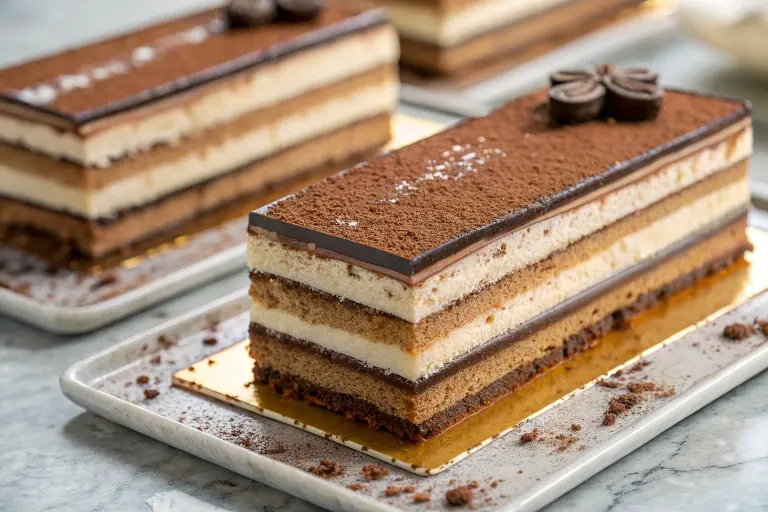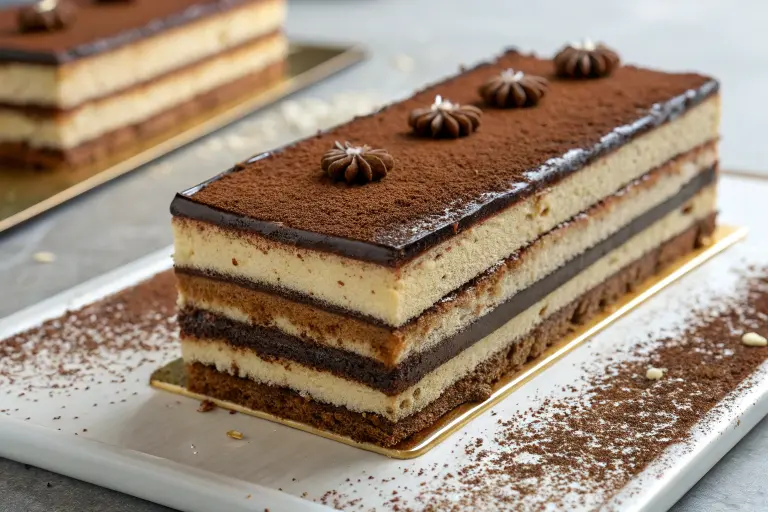Opera cake, a masterpiece of French patisserie, is renowned for its intricate layers and luxurious taste. But have you ever wondered, How Many Layers in Opera Cake define its perfection? This iconic dessert isn’t just about its visual appeal; each layer contributes to a symphony of flavors that has captivated dessert lovers worldwide. Traditionally composed of almond sponge (joconde), coffee buttercream, and chocolate ganache, opera cake combines these elements into a harmonious creation topped with a glossy chocolate glaze.
Whether you’re curious about its origins, the traditional opera cake how many layers it should have, or how to create it at home, this guide will provide all the essential details. From its seven-layer structure to modern variations, we’ll discover everything that makes opera cake a timeless favorite, ensuring you gain a deeper appreciation for this exquisite dessert.
What Is Opera Cake?
Opera cake is a multi-layered dessert featuring alternating sheets of almond sponge cake (known as joconde), coffee buttercream, and chocolate ganache. These layers are typically topped with a glossy chocolate glaze, creating a polished finish.
Key Characteristics of Opera Cake:
- Almond Sponge (Joconde): Light yet firm enough to hold the layers.
- Coffee Buttercream: Adds a rich, aromatic flavor.
- Chocolate Ganache: Provides depth and balance.
- Chocolate Glaze: A shiny and elegant finishing touch.
The precise layering is a hallmark of this cake, making the question of “opera cake how many layers” an essential aspect of its creation.
Opera Cake: How Many Layers Are Traditional?
When it comes to the traditional opera cake, seven distinct layers form its exquisite structure. These layers are meticulously crafted to create a dessert that is as visually stunning as it is delicious. While variations exist, the seven-layer composition remains the gold standard for this classic French treat.
Understanding the Traditional Layers
- First Joconde Layer: This almond sponge layer serves as the base, providing both stability and a delicate flavor.
- Coffee Syrup: A generous brushing of coffee syrup ensures the sponge remains moist while adding a rich, aromatic kick.
- Coffee Buttercream: A silky and flavorful layer that complements the bitterness of the coffee syrup and balances the sweetness.
- Second Joconde Layer: A repeat of the sponge layer to maintain the cake’s structure and texture.
- Chocolate Ganache: This decadent layer introduces a deep, chocolatey richness that contrasts beautifully with the coffee buttercream.
- Final Joconde Layer: The last sponge layer ties the entire structure together, ensuring balance and uniformity.
- Chocolate Glaze: A smooth and glossy glaze finishes the cake, giving it a professional and polished appearance.
Why Seven Layers?
The seven layers in opera cake are not arbitrary. Each one plays a specific role in achieving the cake’s signature taste and texture. The alternating layers of sponge, buttercream, and ganache create a harmonious blend of flavors, while the syrup and glaze ensure a moist and visually appealing result.
Can You Adjust the Number of Layers?
Although seven layers are traditional, some modern variations may include additional layers or reduce the count slightly. For instance, extra ganache or buttercream layers can be added for a richer taste, but it is essential to maintain the balance of flavors to preserve the essence of the opera cake.
Layering Tips for Perfect Opera Cake
To be sure the layers are even and well-defined, consider these practical tips:
- Use a Ruler: Measure each layer to maintain consistent thickness.
- Chill Between Steps: Allow each layer to set before adding the next to prevent mixing.
- Apply Even Pressure: Use a spatula or palette knife to spread buttercream and ganache smoothly.
By following these guidelines, you can replicate the traditional structure of opera cake with precision and finesse.
The History Behind Opera Cake
Opera cake is believed to have originated in France in the early 20th century. While its exact origins are debated, many credit French pastry chef Louis Clichy with its creation. It was later popularized by the Dalloyau patisserie.
The name “opera cake” is said to reflect its elegant and refined nature, reminiscent of the grandeur of an opera performance. The intricate layering is a testament to the precision and artistry of French patisserie.

Tips for Making Opera Cake at Home
Creating opera cake at home may seem daunting, but it is achievable with proper preparation and attention to detail. Here are some practical tips to guide you through the process.
Selecting the Right Ingredients
- Almond Flour: This is essential for the joconde sponge. Choose a fine-quality almond flour for a smooth texture.
- Fresh Butter: For a rich, creamy buttercream, opt for unsalted butter at room temperature.
- Premium Chocolate: High-quality dark chocolate ensures a decadent ganache and glaze.
- Strong Coffee or Espresso: Brewed coffee adds depth to the syrup and complements the chocolate beautifully.
Step by Step Preparation
- Prepare the Joconde Sponge:
- Whip the eggs and sugar until light and fluffy.
- Fold in almond flour and gently incorporate whipped egg whites for an airy texture.
- Bake in thin layers to achieve the characteristic thinness of opera cake.
- Make the Coffee Syrup:
- Dissolve sugar in freshly brewed coffee.
- Allow it to cool before brushing over the sponge to avoid over-soaking.
- Craft the Coffee Buttercream:
- Whip egg yolks and sugar syrup until pale and fluffy.
- Gradually add butter and coffee extract to create a silky texture.
- Prepare the Ganache:
- Heat heavy cream and pour over chopped chocolate.
- Stir until smooth and glossy, allowing it to cool slightly for easier spreading.
- Assemble the Layers:
- Alternate between sponge, syrup, buttercream, and ganache.
- Press each layer gently to ensure an even structure.
- Finish with Chocolate Glaze:
- Pour the warm glaze over the assembled cake.
- Use an offset spatula to spread it smoothly.
Essential Tools
- Offset Spatula: For smooth application of buttercream and ganache.
- Parchment Paper: Make sure easy removal of sponge layers from the pan.
- Ruler: Keeps layers uniform and professional-looking.
- Sharp Knife: For clean, precise cuts when serving.
Pro Tips for Success
- Chill Between Steps: Refrigerate the cake after each layer to ensure firmness and prevent mixing.
- Test the Coffee Syrup: Adjust the sweetness and strength to your preference for the best balance.
- Plan Ahead: Allocate sufficient time for chilling and assembling each layer.
By following these detailed tips and techniques, you’ll be well-equipped to recreate the classic opera cake in your kitchen. The process may be intricate, but the reward is a stunning dessert that delights both the eyes and the palate.
Variations of Opera Cake
While the traditional version remains a favorite, creative variations are emerging. Some popular alternatives include:
- Matcha Opera Cake: Replacing coffee with matcha for a unique twist.
- Berry Opera Cake: Layers infused with raspberry or strawberry flavors.
- Vegan Opera Cake: Substituting plant-based ingredients for a dairy-free option.
- Nutella Opera Cake: A playful version with hazelnut spread.
These variations maintain the essence of opera cake while introducing exciting new flavors.

FAQs: How Many Layers in Opera Cake?
How Many Layers Does an Opera Cake Typically Have?
Traditionally, opera cake consists of seven layers, including almond sponge, coffee buttercream, chocolate ganache, and a chocolate glaze.
Can the Number of Layers Be Adjusted?
Yes, while seven layers are traditional, some bakers may opt for fewer or additional layers depending on their preferences. However, maintaining a balance of flavors and textures is crucial.
What Does Opera Cake Taste Like?
Opera cake offers a harmonious blend of coffee and chocolate flavors, with a subtle almond undertone from the joconde sponge. Its texture is smooth and luxurious.
How Long Does Opera Cake Last?
When stored in an airtight container in the refrigerator, opera cake can last up to 3-5 days. For the best taste, bring it to room temperature before serving.
Is Opera Cake Difficult to Make?
While opera cake requires time and precision, it is not overly complicated. Breaking the process into stages can make it more manageable.
Conclusion: How Many Layers in Opera Cake?
Opera cake stands as a remarkable testament to the finesse of French patisserie, blending layers of almond sponge, coffee buttercream, chocolate ganache, and glaze into a harmonious symphony of flavors. Each layer is a deliberate addition, contributing to the cake’s unparalleled richness and texture. Whether you’re a seasoned baker or a curious dessert enthusiast, understanding opera cake how many layers define its classic form can enhance your appreciation for this iconic creation.
If you’re inspired to try other exquisite desserts, consider our vegan banana pancakes for a plant-based indulgence or the delightful Biscoff cheesecake bars for a nutty and caramel-rich treat. Each recipe offers a unique way to explore the world of flavors and textures, perfect for sharing with family and friends.
As you embark on your journey to create the perfect opera cake or discover new recipes, remember that patience and precision are key. Every layer tells a story, and with a bit of practice, you can bring this timeless dessert to life in your kitchen. Enjoy the process and savor every bite of your masterpiece.
And don’t miss out on more great ideas for healthier baking and cooking. For additional tips, recipes, and updates, follow us on Chaynez Recipes to access our latest posts and social media links.






